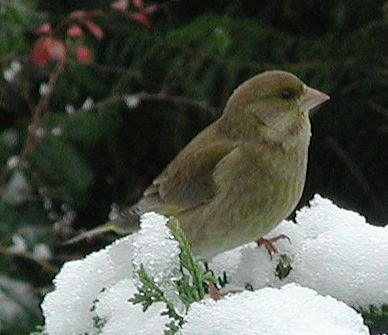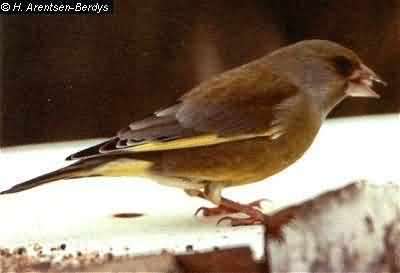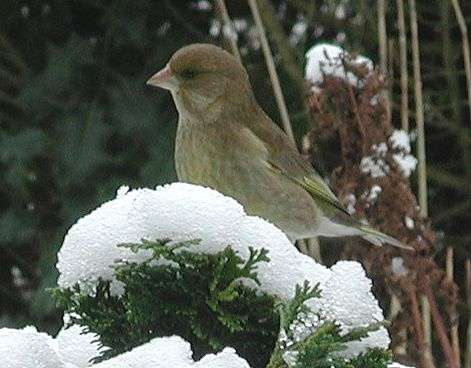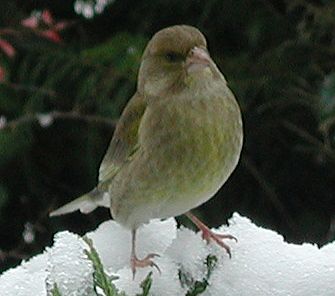[All pictures of garden wildlife on this page are thumbnails. Click on any thumbnail for a large format to be displayed.]
Greenfinch (Carduelis chloris)
Click![]() here for the bird's sound.
here for the bird's sound.

The Greenfinch is a curious and skilful finch.
Of all Finches this is the most common one in our garden. You can see it bathing or drinking in summer, in autumn it will in a flock eat seeds (it's crazy about the fruits of roses) and in winter it will be a daily guest to see what you are offering on the feeding table. During these visits it behaves like a Blue Tit. It too will hang down your peanuts-in-a-bag just as elegantly as the Great Tit. It's undoubtfully the most acrobatic of all the Finches in our garden. It is about the same size as the other finches are (all finches are about the size of a House Sparrow). In Holland it's a widely spread bird that can even be found in smaller gardens in the center of cities. It's pretty song can be heard from late winter onwards. It is also kept in cages (as it has been for centuries) and then it is normally referred to in Dutch as Greenfinch (Groenvink). Actually many of the better known cage birds, such as the canary, are members of the family of finches as well.

De Groenling valt vooral op door de geelgroene vleugelstreep.
Outside the breeding season you will always find greenfinches in small flocks. The bird very well adapted to human activity. They will nest in the middle of big cities. The bird is very common in Holland indeed.


The young birds show more stripes on their chest than the adults do.
This bird belongs to the family of Finches (Fringillidae). It is common in our garden and can be seen in Holland all year round. The bird is 6" and weighs 30 grams. It lives in woodlands, parks and gardens mostly. It eats seeds, buds and berries. Compared to the male, the female is more greyish. Like mosr finches the nest is made in trees and shrubs from april to august. Usually some four to six eggs are produced, on which the birds will sit for 13 days. After hatching the youg remain in the nest for a period of some 15 days.
| Name of this bird in various other languages | ||||
| Dutch | German | French | Polish | Scientific |
| Groenling | Grünling | Verdier d'Europe | Dzwoniec | Carduelis chloris |

© Copyright 1998-2024 gardensafari.net (Hania Berdys)

 English / engels
English / engels  Dutch / nederlands
Dutch / nederlands